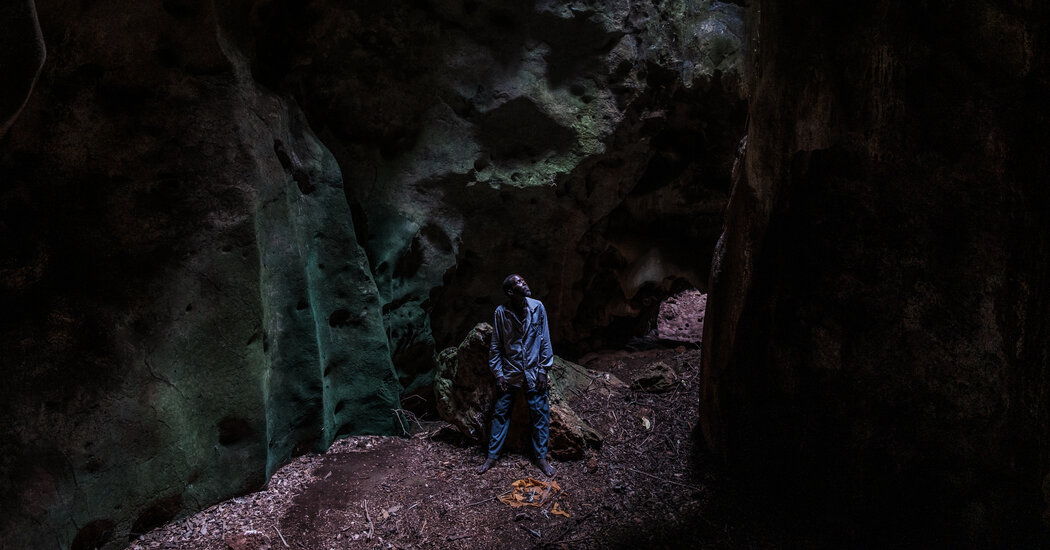
Africa|How Kenyan Villagers Saved Their Sacred Caves From a Mining Company
https://www.nytimes.com/2025/09/19/world/africa/how-kenyan-villagers-saved-their-sacred-caves-from-a-mining-company.html
How Kenyan Villagers Saved Their Sacred Caves From a Mining Company
An Emirati-backed cement project threatened ancestral prayer caves. The community fought back.
Lugadi Runya Shipa inside one of the caves in eastern Kenya. For generations, men like him have guided worshipers through the caverns.Credit…
Beneath the black rocks of eastern Kenya, the land splits open into a secret underworld — a labyrinth of ancient caves formed over millions of years. In their cool chambers, where violet flowers bloom in the dark and the bones of ancestors were found, the Chonyi people whisper prayers, make offerings and tie ribbons to stone walls to summon spirits.
For generations, custodians like Lugadi Runya Shipa have guided worshipers through the caverns, just as his father and grandfather once did. In one chamber, he offers thanks to the spirits, sometimes by sacrificing a goat.
“I know they can hear me,” he said in the darkness.
But for the past five years, Mr. Shipa and his community have fought a battle few believed they could win, when an Emirati-backed company aimed to bulldoze over 600 acres of land — including most of the caves — to make way for cement production.
Last month, against the odds, they won. A Kenyan court revoked the company’s licenses after residents and environmental groups challenged the project.
Map locates Chasimba, in Kilifi County near the Kenyan coast.
SOUTH
SUDAN
Ethiopia
somalia
Uganda
Kenya
Lake
Victoria
Nairobi
Kilifi
Tanzania
Chasimba
Mombasa
Indian Ocean
100 miles
The win stands out in a region where mining companies are rapidly redrawing the landscape. Along Kenya’s coast, titanium and cement firms have secured large areas for extraction, often under agreements that have drawn criticism for lack of transparency, limited community input and broken promises around jobs and development.
The victory feels fragile.
The court ruling ends a bitter dispute that has split this impoverished community and exposed broader tensions between economic development and cultural preservation. While some feared the loss of a way of life and irreplaceable heritage, many families chose to sell their land, hoping the company would deliver on its promises of jobs and a better future for their children.
Even the Kenyan government was divided. The mining minister visited the site, and his ministry endorsed the project, seeing it as a way to attract much-needed foreign investment amid a deep recession. But the National Museums of Kenya, an agency run under the culture ministry, quietly opposed it. In an internal letter that was not made public, the museums warned the project would permanently destroy part of the country’s cultural legacy and nominated the caves for UNESCO World Heritage status.
“Loss of this living heritage space through human destruction will cause irreversible damage to the community’s identity,” the museum said in their submission.
‘The Investor’
Perched a few hundred feet above the Indian Ocean, Chasimba’s hills are home to about 20,000 people, most from the Chonyi community, one of the coast’s oldest inhabitants.
Life here moves to rhythms older than the nearby coastal towns: maize and coconut harvests, communal gatherings, and prayers in the caves that cover this ancestral land. Many families live in wooden houses scattered across farmland, with no electricity and no running water. The area has just one small hospital.
Then, in late 2019, a stranger arrived with a proposition that would change everything. He promised jobs, safer roads, clean water and a new hospital.
Michael Njoroge, a Kenyan entrepreneur based in the United States, had spent some time searching for the right site to build what he envisioned as one of Kenya’s first hydrogen-powered cement plant.
After visiting other places in the country, he landed on Chasimba, a remote settlement with one extraordinary resource beneath its soil: nearly 100 miles of ancient limestone. This limestone, when heated and crushed into a fine powder and mixed with clay, becomes cement when water is added. The reserves could last over a century, he said.
Mr. Njoroge worked with Super Cement, an Abu Dhabi-based firm, to back the $90 million venture. He called the plant Mashujaa — “heroes” in Swahili — and promised it would bring generational change to a neglected place.
“We want to bring value to a very depressed community,” Mr. Njoroge said in an interview from a coastal hotel last year, adding that the company intended to preserve 6.7 acres containing the Mawe Meru caves, one of the most famous sacred sites for the Chonyis.
But to build the project, he needed land. Lots of it.
Mr. Njoroge set out on a complicated mission. He tracked down hundreds of landowners in the hills of Chasimba, many of them unknown since owners often died without wills or deeds. He visited homes, identified heirs, attended elders’ meetings and town forums.
“He was everywhere,” said Salim Chibo, a longtime resident. “We called him the investor.”
At first, many listened with cautious hope.
With seven children to feed and land too rocky to farm, Kevin Mwachimunye said the promises felt like salvation. In 2020, he sold just over four acres.
“This could have a multiplier effect,” he said. “Maybe we could open a small shop and sell food.”
Many followed. But some were uneasy. As the land sales accelerated, so did the cracks in the community. Clans split. Siblings stopped speaking.
Kai Mwahunga said he learned that a relative living out of town had sold his family’s land without informing those still living on it. As a result, he feared eviction from his home.
Even those who received payment said it was too little. Land sale documents reviewed by The New York Times show Mashujaa typically offered between 200,000 and 300,000 Kenyan shillings per acre ($1,500 to $2,300) — often split among multiple households. Several families said what remained was not enough.
The Fight
As doubts grew, so did frustration. Many residents said they felt pressured to sell — not just by the company, but by their own government officials.
Umazi Shera recalled a visit in late 2021 from the local chief, Rueben Ndago. “He said if we didn’t sell, the government would take our land,” she said. Her son urged her to stand firm.
Internal records show the now former chief was more than a messenger. As a documented ally of the company, he organized sale meetings, went door to door, and served as Mashujaa’s legal witness in the appeal brought by residents and environmental groups.
In an interview last October, journalists found Mashujaa officials operating directly from Mr. Ndago’s home. He denied claims of coercion.
“Nobody was forced to sell,” he said.
Soon after Mr. Njoroge arrived in Chasimba in 2019, a small group of residents and environmentalists began to push back. Leading the fight was Dr. Mtana Lewa, a Chonyi elder, former member of parliament and conservationist.
He and fellow villagers launched a layered strategy. They enlisted other traditional elders, cultural and environmental groups, scientists and lawyers. By 2024, they had filed a series of complaints to Kenya’s environmental regulator — each submitted by a different institution, building a case piece by piece.
The Malindi Museum Society questioned sacrificing heritage for profit. The National Museums of Kenya warned of irreversible cultural loss. Nature Kenya, the country’s oldest environmental organization, documented rare species threatened by mining. Even the government’s Environmental Complaints Committee opened an investigation into whether community consultations had been manipulated or rushed.
They worked with the Caves Exploration Group of East Africa to document newly discovered caves. And they lobbied the government to nominate the site for UNESCO protection, which it did in June 2023.
Still, in July 2024, Mashujaa received its first mining license.
The coalition responded immediately, filing an appeal with Kenya’s National Environment Tribunal, halting operations before they could begin.
“What he was hoping for was that he’d get the license and nobody would speak up,” Dr. Lewa said of Mr. Njoroge. “But we know our rights. And we fight for them.”
The Verdict
This August, the court ruled in the residents’ favor, citing the caves’ cultural significance, rare ecosystems and a failure to properly consult the community about the project’s risks and benefits.
“They took advantage that the local community are maybe kind of illiterate and they didn’t really value their land well,” said Duncan Onyango, who works with the environmental court.
Mashujaa has not said whether it will appeal.
“I have no comment at this moment,” Mr. Njoroge told The Times on the day of the judgment.
But even in victory, many families now face an uncertain future. Mashujaa still owns the land, and under Kenyan law, families who sold their plots cannot reclaim them, Mr. Onyango said.
Deche Guni thought he was making a smart choice when he sold to Mashujaa. But he said the payout wasn’t enough to build a better life. Today, he lives in an unfinished house with holes in the walls. He has no money left.
Others still hope the company will build, bringing jobs, opportunity and a way to profit from the land they sold.
In the depths of the caves, healers like Selina Chiwetse Jefwa are sill carrying out their rituals.
Her ceremonies gather a circle of women who chant prayers to summon spirits. They burn fragrant incense, sprinkle rose water over their client’s shoulders and play percussion. The ritual ends in a crescendo of singing and dancing in the limestone cave.
Sarah Hurtes is a Times reporter working on international investigations from Brussels.
See more on: Unesco
Related Content
Advertisement
SKIP ADVERTISEMENT



